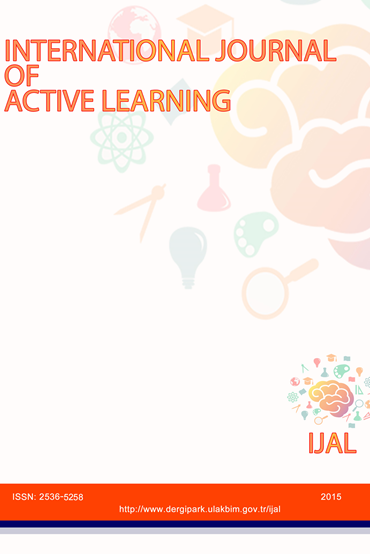The Implementation of Active Learning for Fifth Grade English Learner in Secondary School
Active learning, multiple Intelligence, learning by experiencing, secondary school students
The Implementation of Active Learning for Fifth Grade English Learner in Secondary School
Active Learning, Multiple Intelligence, learning by experiencing,
___
- Alves M. (2015). Ways to Apply Active Learning in the College ESL Classroom: The Old, The New, and Experiments in Teaching Techniques for Teaching with Active Learning
- Atake, K. (2003). Using Games to Teach English in Japanese Junior High School.
- Attaran A., Gholamı V. & Moghadda M. M. (2014). The Effects of Active Learning on Foreign Language Self-Concept and Reading Comprehension Achievement
- Chen, J-Q., & Gardner, H. (2005). Assessment based on multiple intelligences theory. In D. P. Flanagan (Ed.), Contemporary Intellectual Assessment: Theories, Tests, and Issues (77-102). New York: Guilford Press.
- Er M., Altunay U. & Yurdabakan İ. (2012). The Effects of Active Learning on Foreign Language Self-Concept and Reading Comprehension Achievement
- Eslit E. R. (2017) Computer Assisted Language Teaching: Learning without Dust.
- Garrett, N. (2009). Computer‐assisted language learning trends and issues revisited: Integrating innovation. The modern language journal, 93, 719-740.
- Gholami, V., Moghaddam, M. M., & Attaran, A. (2014). Towards an interactive EFL class: Using active learning strategies. The Clarion-International Multidisciplinary Journal, 3(2), 67-74.
- Gündüz N. (2005) Computer Assisted Language Learning. Journal of Language and Linguistic Studies (Vol 1, No2.)
- Kitaw, Y. Z. (2017). Active learning in teaching English language support courses to first-year students in some Ethiopian universities (Doctoral dissertation).
- Komur,S. Gursan, S. Seker, H. ( 2005) Teaching English Through Songs. Muğla University Social Sciences Journal, 15,109-118
- Mulatu, M., & Bezabih, W. (2018). Perceptions and practices of EFL teachers in implementing active learning in English classes: the case of three selected secondary schools in Dawro zone, SNNPRS, Ethiopia. International Journal of Education, 10(2), 88-94.
- Zewdu K.Y. (2017) Active Learning in Teaching English Language Support Courses to First-Year Students in Some Ethiopian Universities
- ISSN: 2536-5258
- Başlangıç: 2015
- Yayıncı: Meryem Nur AYDEDE
Fen Lisesi Öğrencilerinin Bilgisayara Yönelik Tutumlarının İncelenmesi
The Implementation of Active Learning for Fifth Grade English Learner in Secondary School
Mehmet Burçin ÖZKAN, Tugba BADEMCİ
Sümeyra YILMAZ, Bülent AYDOĞDU
Eyüp ARTVİNLİ, Hale ÇETİNTAŞ, İrfan TERZİ
Lise Öğrencilerinde Sosyal Görünüş Kaygısı ve Fiziksel Aktiviteye Katılım Motivasyonu İlişkisi
